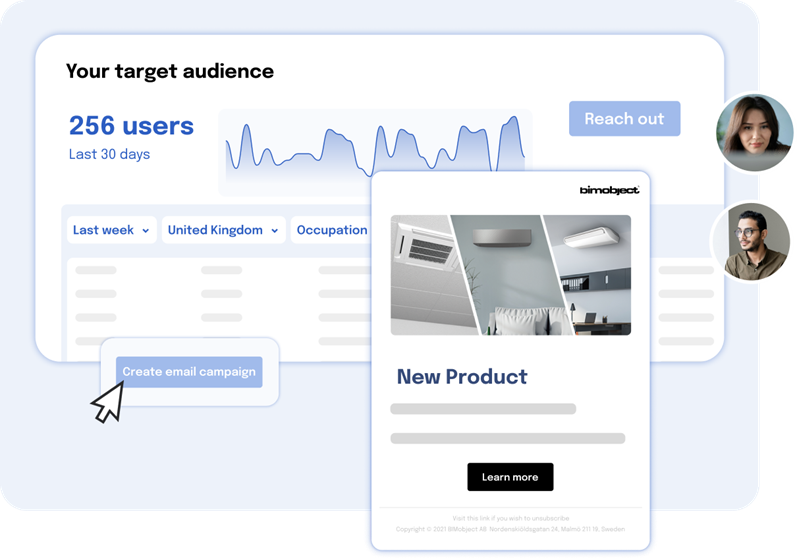
The Importance of Lead Generation in Manufacturing Companies
Manufacturing companies need more than traditional methods to acquire leads. Imagine your outreach efforts being precisely targeted, reaching potential clients who are genuinely interested in your offerings.
Lead generation is essentially building a pipeline of prospective customers who can be engaged, educated, and ultimately converted into clients who fit the ideal profile within a specific industry or market.
By generating and qualifying leads, you can consolidate your sales process, target the right audience, and increase your chances of growing your business. Building product manufacturers must be ready to serve their clients, respond to the construction industry’s new demands, and view product data as a critical asset that can change how the market meets customer expectations.
Understanding potential customers' needs and preferences is important for tailoring marketing efforts and nurturing B2B relationships. In today's digital era, B2B interactions often start online, and having a solid strategy is the key.
The BIM Advantage and BIMobject’s role:
Identifying your target audience is important for successful marketing. Manufacturers in the construction sector focus on AEC professionals—architects, engineers, and construction experts—as their primary target audience. Understanding their roles and preferences is essential to tailoring your marketing strategies effectively.
But do you know the best way to reach your target audience today?
BIM (Building Information Modeling) has become the preferred method for working digitally in construction. It enables people who build and maintain buildings to understand every aspect of them, from their appearance to their functionality.
In marketing terms, BIM is indispensable for audience data tracking and understanding the needs of AEC professionals.
Lead generation marketing involves attracting potential customers, engaging them, and ultimately converting them into buyers. However, every organization's approach to defining leads varies.
Downloading BIM content often signals product interest. When someone downloads your products on BIMobject, they essentially become a lead for your company.
You might be asking yourself why BIM is so crucial for AEC professionals. BIM is the modern method by which AECs operate and find products for their projects. Therefore, BIM is the key to getting your products noticed and specified. According to USP’s Architectural Barometer report, 44% of architects used BIM in 2022, which is expected to increase to 61% by 2025.
BIMobject's platform is the link between manufacturers and specifiers. Architects, engineers, and designers rely on online BIM libraries to find objects that meet their project requirements. Architects and designers who access and integrate BIM objects into their projects express interest in those products. This allows manufacturers to capture warm leads—those who are already exploring products within the context of a project—and tailor their follow-up efforts accordingly. With BIM’s data-driven nature, tracking engagement patterns over time can reveal trends and opportunities for refining strategies later. Manufacturers can collect strategic data to act on trends, promote products, and understand user preferences.
BIMobject also operates globally, connecting manufacturers with professionals in different countries and regions. This global reach expands manufacturers' opportunities to tap into new markets.
Are you considering turning your product catalog into BIM objects to meet the needs of your target audience? Contact us today!

Transforming Your Product Catalog into BIM objects: A Marketing Strategy
Many building product manufacturers understand the importance of offering their products as BIM content on platforms like bimobject.com. As a result, you get improved brand visibility throughout the construction process and increase awareness and consideration among the key players in BIM projects.
Moving your product offering into the digital realm is key to establishing a strong lead generation strategy. This means drawing in potential customers, keeping them engaged, and ultimately turning them into buyers. However, every organization may have its own way of identifying leads.
When an AEC professional downloads your BIM content, it signifies interest in your product. This action essentially converts them into leads for your company.
With over 14 years of experience, we've assisted manufacturers in digitizing their product catalogs. Our BIM files have been widely downloaded, incorporated into design models, and specified in projects globally.
Our platform boasts over 5 million users, primarily architects and engineers seeking content. They choose BIMobject because it offers a direct-to-design channel, allowing them to integrate products into their digital designs with a single click.
As design decisions increasingly occur on BIM marketplaces like ours, manufacturers without BIM content risk exclusion from project consideration.
Are you thinking about investing in BIM content but not sure which pain points it solves? Let Marta Gutiérrez, an Architect and BIM Consultant, answer those questions.
Omni-Channel Marketing: Expanding Your Reach
While your website remains an essential touchpoint, its reach may be restricted and is no longer sufficient. To fully expand your market presence, it is important to have your products available across diverse online platforms. Omni-channel marketing ensures that your offerings can be accessed through multiple channels beyond your website, broadening a wider net for potential leads and broader audience reach.
Integrating omnichannel strategies into your digital marketing strategy increases your brand's visibility and demonstrates your commitment to meeting your audience where they are. As a result, you're expanding your reach and laying a strong foundation for lasting customer relationships.
Discover how AkzoNobel Industrial Coatings through BIMobject has become an important part of an omni-channel strategy.

Precise Targeting for Effective Outreach
Traditional lead generation strategies often involve a broad approach that may result in reaching out to individuals or companies that aren't genuinely interested in your products. With BIMobject, manufacturers can cater to specific industries or project types. For instance, a manufacturer of HVAC equipment can create distinct BIM objects for commercial and residential applications. This customization ensures that outreach efforts are well-aligned with the potential client’s needs, increasing the likelihood of generating qualified leads.

How BIMobject marketing tools help you reach your target audience
BIMobject's platform offers a diverse range of marketing solutions to capitalize on opportunities:
-
Promoted products increase visibility and drive downloads. For instance, VELUX experienced an 870% surge in VELUX Top Hung INTEGRA® GPU downloads on the first day of utilizing this feature.
-
Analyze gives manufacturers insights into brand reach and user interactions, such as follows, visits, and downloads. These insights are crucial for understanding client needs and driving business growth.
-
The Email Campaigns tool enables manufacturers to engage and follow up with individuals who interact with their brand and products. This is accomplished by creating, segmenting, and delivering behavior-based and relevant marketing messages directly to their audiences’ inboxes. Has your target audience shown interest in your products? Email campaigns on our platform are the best way to nurture your leads all the way to specification.
Getting your BIM objects in front of the right audience shouldn't be difficult. Our features make it easier for customers to define and target their target audience through promotional tactics. Manufacturers using email campaigns on BIMobject get a 74% higher open rate and a 4% higher click rate than the industry standard. Moreover, brands using promoted product promotions see an average of 83% growth in monthly downloads and followers over the year.
The Risk of Inaction: Consequences of Not Adapting
While certain companies have fully embraced digital processes, others are only partially aware of the need to eventually take action.
The consequences of not embracing digitalization and a digital marketing strategy are significant. Failing to adapt means skipping the opportunity to connect with your audience and build fruitful relationships. This can also lead to lost revenue. Your competitive advantage diminishes as competitors who have integrated BIM into their strategies gain attention and secure deals. Reluctance to evolve in a rapidly changing landscape can result in a weakened market position.
Want to strengthen your digital marketing strategy with BIMobject? Discover all the advantages of BIMobject for marketers.

Denisse Luna
Content Marketer








